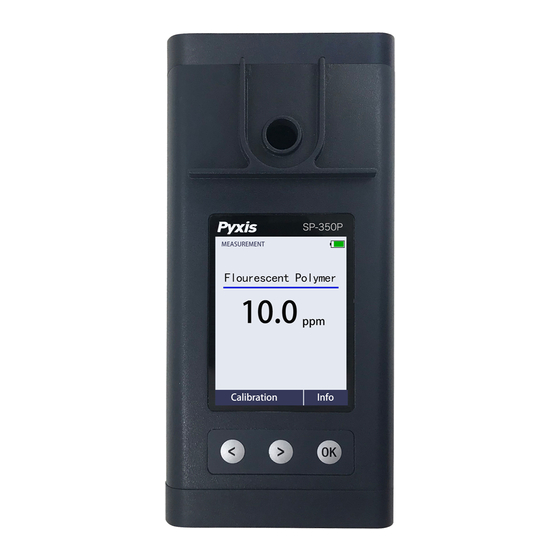
Table of Contents
Advertisement
Quick Links
Advertisement
Table of Contents

Summary of Contents for Pyxis SP-350P
- Page 2 Fluorescent Polymer Handheld User Manual October 12, 2020 Rev. 2.00 Pyxis Lab, Inc. 1729 Majestic Dr. Suite 5 Lafayette, CO 80026 USA www.pyxis-lab.com © 2017 Pyxis Lab, Inc. Pyxis Lab Proprietary and Confidential...
-
Page 3: Table Of Contents
11.1 Maintenance Best Practices and Quick Tips ......11.2 Methods to Cleaning the SP-350P ...... - Page 4 13 Contact Us SP-350P User Manual service@pyxis-lab.com | +1 (866) 203-8397...
- Page 5 Pyxis Lab, Inc. Standard Limited Warranty Pyxis Lab warrants its products for defects in materials and workmanship. Pyxis Lab will, at its option, repair or replace instrument components that prove to be defective with new or remanufactured components (i.e., equivalent to new).
-
Page 6: Introduction
1 Introduction The Pyxis SP-350P is a uniquely designed handheld multimeter that measures Fluorescent Polymer. It is a cuvette-less device. Less than 5 mL water sample is needed to fill the sample cell for proper measurement. 1.1 Main Features The Pyxis SP-350P analyzer measures the concentration of Fluorescent Polymer of a water sample and includes the following features: •... -
Page 7: Unpacking Instrument
The SP-350P battery compartment, shown in Figure 1, is on the back side of the instrument. Batteries are held in place by a cover secured with two Phillips-head screws. -
Page 8: Instrument Overview
4. Replace the battery compartment cover and ensure that the sealing O-ring is lying flat on the battery holder. 5. Fasten the two screws. NOTE Failure to properly seat the O-ring may result in water damage to the SP-350P. 5 Instrument Overview Figure 2. SP-350P User Manual service@pyxis-lab.com... -
Page 9: Control Keys
To turn off the SP-350P: Press and hold for about three seconds. Release when the LCD display turns off. The SP-350P turns itself off after 60 seconds without user interaction detected. This is done to conserve battery life. NOTE This auto-time off setting may be customized by the user as desired through the uPyxis®... -
Page 10: Calibration
DI water for the zero step as soon as it is available. 2. Power on the SP-350P by pressing . Allow 5–10 seconds for the SP-350P to stabilize. 3. The unit is actively reading and displaying Fluorescent Polymer. The values will be very low if DI water is used;... -
Page 11: Device Information And Diagnosis
(Figure 7). The information has no use for normal operation, but instead is used for device troubleshooting. Provide an image of both the DEVICE INFORMATION screen and the SYSTEM DIAGNOSIS screen when you contact Pyxis (service@pyxis-lab.com) for troubleshooting your device or call +1 (866) 203-8397. -
Page 12: Sample Cell Cleanliness Check
The SP-350P is designed to provide reliable and accurate measurement on HST. Heavy fouling will pre- vent the light from reaching the sensor, resulting in inaccurate readings. It is suggested that the SP-350P be checked for fouling and cleaned on a monthly basis. Heavily contaminated waters may require more frequent cleanings. -
Page 13: Bluetooth Connection To Devices
8.2 Bluetooth Connection to Devices The SP-350P uses a built-in Bluetooth Low Energy Connection (BTLE) to connect wirelessly to a smart phone via the uPyxis® Mobile App or to a computer via the included Bluetooth Adapter (P/N: MA-NEB) and the uPyxis®... -
Page 14: Use With Upyxis® Mobile App
Mobile App. Ensure that the SP-350P is discoverable by following the steps in the Bluetooth Connection to Devices section. Once the app is open, the app will start to search for the SP-350P. When the uPyxis® Mobile App connects to the SP-350P, then press on the SP-350P. -
Page 15: Setting Screen
When connected, the uPyxis® Mobile App will default to the Setting screen. From the Setting screen, the user can set the Power off time and Screen off time in seconds. Figure 15. SP-350P User Manual service@pyxis-lab.com | +1 (866) 203-8397... -
Page 16: System Screen
The firmware update process takes some time and will require the SP-350P to stay within range (approximately 10 ft without obstructions) for the entire duration of the update. Once the update is complete, the SP-350P will reboot which will disconnect the SP-350P from the uPyxis® Mobile App. Figure 16. -
Page 17: Connecting To Upyxis® Desktop App
10.2 Connecting to uPyxis® Desktop App Ensure that the SP-350P is discoverable by following the steps in the Bluetooth Connection to Devices section. Once the app is open, to find your device, click on Device, then Connect via Bluetooth.. -
Page 18: System Screen
The firmware update process takes some time and will require the SP-350P to stay within range (approximately 10 ft without obstructions) for the entire duration of the update. Once the update is complete, the SP-350P will reboot which will disconnect the SP-350P from the uPyxis® Mobile App. Figure 19. -
Page 19: Datalog Screen
10.4 Datalog Screen From the Datalog screen, the user can view, delete, and export the internal log files of the SP-350P by clicking Read Datalog List and selecting the desired datalog (these are separated by month). The SP-350P will then populate any relevant log event from the selected datalog which can be viewed in more detail by... -
Page 20: Device Maintenance And Precaution
11 Device Maintenance and Precaution 11.1 Maintenance Best Practices and Quick Tips For greatly increased working life and ease of use of the SP-350P follow the list of maintenance best practices and quick tips below: • Rinse the sample cell at least three times with the desired solution before turning on. -
Page 21: Storage
12 Regulatory Approval United States The SP-350P sensor has been tested and found to comply with the limits for a Class B digital device, pursuant to part 15 of the FCC Rules. These limits are designed to provide reasonable protection against harmful interference in a residential installation.
















Need help?
Do you have a question about the SP-350P and is the answer not in the manual?
Questions and answers